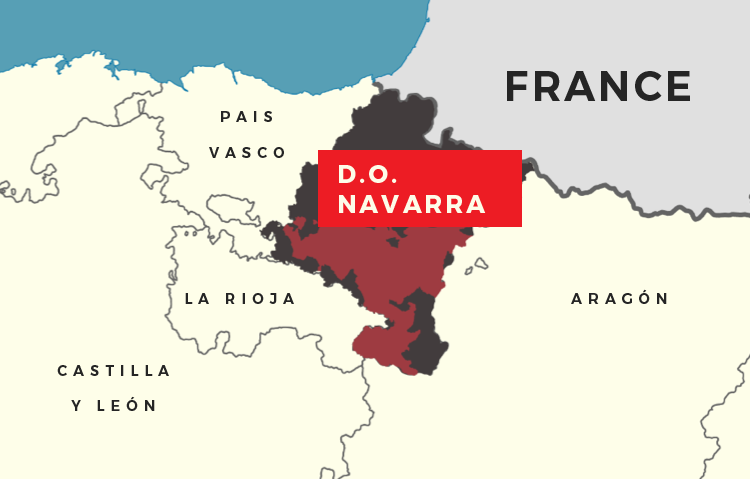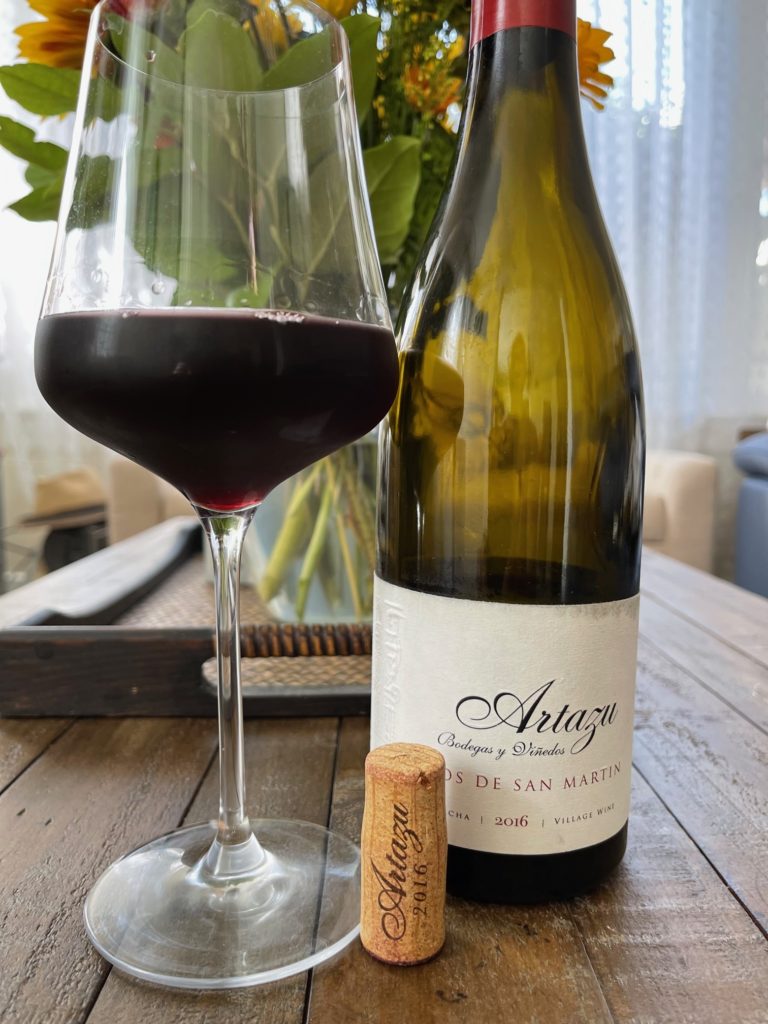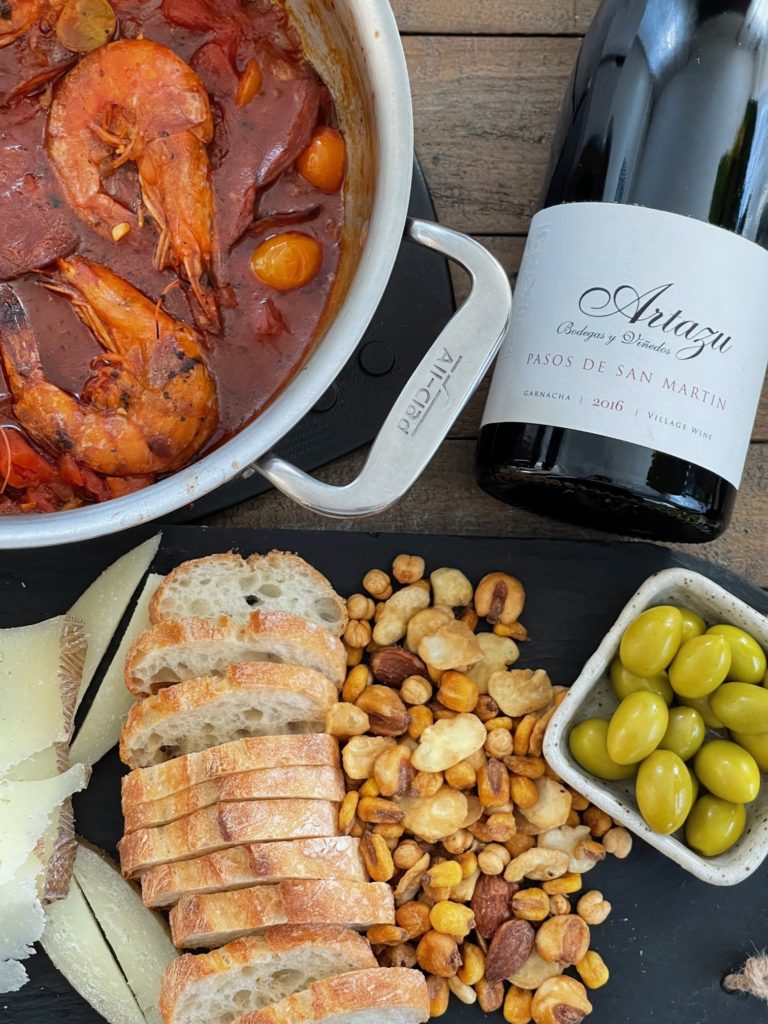This month the intrepid #WorldWineTravel group of bloggers continues its 2021 virtual exploration of Spain with a visit to the Navarra wine region in northern Spain, hosted by Robin of Crushed Grape Chronicles.
About Navarra
Situated in Northern Spain, Navarra’s vineyards can be found from the foothills of the Pyrenees Mountains to the Ebro River Valley (which it shares with its illustrious neighbor – Rioja; whose territories sit in both Navarra and the province of Álava (in Pais Vasco) between Madrid and San Sebastian. It is located along the Camino Santiago as you travel north east from Rioja towards its capital city of Pamplona, famous for the annual Fiesta de San Fermin, also known as “the running of the bulls.”

There is an interesting confluence of three climates in Navarra (Atlantic, Continental and Mediterranean from north to south). The trio of climate types combined with a range of soils, altitude, sunshine and rainfall in an area that’s only 120 miles north-south and 60 miles east-west, allows the region to produce a diverse variety of styles of wines from many different grape varieties.
Winemaking in the region dates back to ancient Roman times, but grapes were almost certainly thriving here before that. Prehistoric Vitis sylvestris species vines – predecessor of the cherished Vitis vinifera – have recently been discovered still growing in Navarra. Learn more about Navarra’s amazing history (1)
The 14th Century was a boom time for Navarra and the number of vineyards multiplied to the extent that land use restrictions had to be imposed to ensure farm land was dedicated to crops to feed the local population. Demand received an additional boost in the late 19th Century when France was hit by phylloxera. But the rise in sales was short-lived because phylloxera arrived in Navarra a few months after it devastated France. The sap-sucking bug destroyed around 90% of the Navarra vineyards. They were replanted in the 20th century with vines that were resistant to the bug.
The DO was established in 1933, and its regulating body, the “Consejo Regulador de la Denominacion de Origen Navarra” was established in 1958.
Navarra At-A-Glance
Area under vine: 28,417 acres
Grapes planted:
Reds: 90%: Predominantly comprised of 23% Tempranillo, 24% Garnacha, 15% Cabernet Sauvignon, and 14% Merlot
Whites: 10%: Predominantly comprised 5% Chardonnay, 2% Viura, and 1% Moscatel and Garnache Blanca
Sub regions: Tierra Estella, Valdizarbe, Baja Montaña, Ribera Alta, Ribera Baja
Soils: The Tierra Estella hills have a high limestone content and can be extremely rocky; Valdizarbe has marl, loam and alluvial soils. Baja Montaña marl, loam, sand and limestone. Through Ribera Alta and into Ribera Baja, soils get poorer and sandier
Annual production: ~5.4 million cases; 63% red, 25% rosé, 11% white
2016 Artazu “Pasos de San Martín”
Fruit for this wine is sourced from organically farmed 35 year-old vineyards situated on a slope at more ~2,000′ elevation near the medieval village of San Martín de Unx in the sub-region of Valdizarbe, which is is the most humid, and Atlantic influenced sub region. Fermented in stainless steel. Aged in 500 litres French oak barrels for 12 months.

Tasting Note: Translucent dark ruby color with black and red fruit, forest floor, dried herb, and subtle floral aromas. On the palate it’s medium-bodied and very fresh with fine-grained tannins and ample fresh black cherry, strawberry leather, black raspberry and licorice flavors with engaging savory, herbal notes and a very satisfying finish. 100% Grenache. 90pts|14.5% abv| SRP – $26
This wine is emblematic of the compelling quality/price ratio of Spanish wine. I recently enjoyed a highly acclaimed 100% Grenache from California. It was an outstanding, but it was also ~$75. As much as I enjoyed it, for the price it was a one-time indulgence. On the other hand, I enjoyed this wine nearly as much and it was 1/3 of the price, and it’s a wine I’d gladly put on repeat.
Food Pairing
For a taste of Spanish culture we shared tapas of Manchego cheese, sliced baguette, Mitica Spanish Cocktail Mix, and Marrakesh Spiced Olives, along with a “ración” of One Pain Spanish Chorizo and Shrimp.

The wine was awesome paired with our meal across the board!
About Bodegas y Viñedos Artazu
In 1996, Artadi founder and Rioja Alavesa native Juan Carlos López de Lacalle, inspired by his friendship with pioneering Central Coast vintner (and Grenache aficionado) Randall Graham of Bonny Doon, made his first winemaking foray into the neighboring historically Basque region of Navarra. There, Lacalle acquired the then-derelict town cooperative of Artazu, and began tending the Santa Cruz, the choicest plot of old bushvines of Garnacha and Garnacha Blanca in the the village. Later, further plots were acquired in the town of San Martín de Unx, from which a ‘village’ wine has been produced since 2011. The ultimate result, after more than two decades of careful winemaking and organic farming: a beautiful and fresh expression of Atlantic Garnacha, one that stands proudly alongside the increasing wealth of high-altitude, cooler-climate Garnacha being produced in Spain today explains importer Skurnik.
If you are reading this early enough, please join the conversation on our Twitter chat at 8am Pacific time on Saturday, September 25th. Just follow the hashtag #WorldWineTravel and be sure to add it to whatever you tweet so we can see here. Here’s the #WorldWineTravel bloggers’ virtual trip to Navarra.
- Wendy of A Day in the Life on the Farm shares Sazon Goya Grilled Chicken Thighs and an Old Vines Garnacha
- Terri of Our Good Life shares Navarra’s Local Red Wine Drink: The Kalimotxo #worldwinetravel
- Martin of Enofylz Wine Blog shares 2016 Artazu Pasos de San Martín” Navarra + One Pan Spanish Chorizo & Shrimp
- Nicole of Somm’s Table shares Azul y Garanza Naturaleza Salvaje Navarra Tinto with Basque Tomato Soup and Grilled Chicken
- Cam of Culinary Adventures with Camilla shares Virtual Navarra: Spicy Lamb Meatballs + Vina Zorzal Graciano 2018
- Jeff from Food Wine Click shares Surprisingly Fresh in Navarra with Itxas Harri
- Gwendolyn Alley from Wine Predator shares Chorizo Stuffed Mushrooms with Navarra’s “Galimatias” Cuts Through The Rigmarole
- Susannah from Avvinare shares Discover Navarra Rosados that Brighten your Day
- Robin on Crushed Grape Chronicles shares Gardacho Garnacha from Navarra and Pochas Estofadas
Related Articles You May Be Interested In:
Our previous virtual visits so far this year included (click on link for my posts):
- January; La Rioja
- February; Catalunya-Penedes-Cava-Priorat-Monstant
- March; Castilla y Leon-Ribera del Duero, Rueda, Toro
- April; Galicia-Rias Baixas
- May; Cariñena
- Jun; Basque Country
- July; Spanish Cider from Asturias
- August; Murcia and Valencia
Also, in 2017, I shared “A Taste of Navarra Wine; Spain’s Best Kept Secret“
References:
- Navarra Wine U.S.; History of Navarra
We’ve been all around the region and yet to be IN it. Spain is very close to the top of the list when we can travel a bit more freely and we’re going to see if we can find this wine to do some proper ‘research’ ;).
Absolutely fascinating! I love that the wine is “Pasos de San MARTIN”! seems appropriate.
What a fascinating history behind Bodegas y Vinedos Artazu. More of those names popping up…that he was inspired by Randall Grahm and that then he began tending a vineyard named “Santa Cruz” . I love that he is revitalizing what was a derelict co-op,
On top of that the wines sounds delicious, reasonably priced and your pairings, as always have me hungry!
What a nice pairing and what a wonderful find as compared to that bottle you enjoyed from CA.
That shrimp and chorizo dish looks fabulous!! 😋
Thanks so much Lisa. It was so tasty!
The shrimp and chorizo look fantastic! The fact that it’s one pan is even better! I don’t think I’ve had this one, but have enjoyed bottles from this producer and really enjoyed!
Thanks Nicole. My first bottle from Artazu. Will definitely keep an eye out for others!